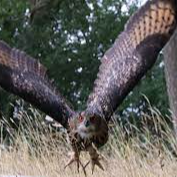The Largest Birds In The World
13.2K
5

About
Do u know?
Algeria
Description
A considerable lot of the birds we experience in our everyday lives are minuscule, frequently weighing only a couple of grams. In any case, a few types of bird are shockingly huge, arriving at statures significantly more prominent than the tallest people. The greater part of the biggest birds on the planet are flightless which permits them to have denser bones and heavier bodies. They have developed different qualities to permit them to get away from hunters, for example, solid, amazing leg muscles which implies they can run at high paces. Ostriches Ostriches (Struthio camelus) are the biggest living birds on the planet, with a normal mass of 104 kg and normal length of 210 cm. They lay the biggest eggs and hold the record for the quickest land speed of any bird, arriving at rates of 70 kmph. It is additionally believed that ostriches have according to any land vertebrate whatsoever mm in breadth. Ostriches are local to Africa yet are cultivated everywhere, especially for their quills, skin which is utilized in calfskin items, and meat. In 2014, the Somali ostrich (Struthio molybdophanes) was perceived as an unmistakable animal types. Cassowaries The southern cassowary (casuarius), otherwise called the twofold wattled cassowary, Australian cassowary or two-wattled cassowary have a normal load of 45 kg and are around 155 cm long. Southern cassowaries are found in north-eastern Australia, Indonesia and New Guinea. Northern cassowaries (Casuarius unappendiculatus) otherwise called the single (one)- wattled cassowary or brilliant necked cassowary, are somewhat more modest with a normal load of 44 kg and normal length of 149 cm. They are endemic to northern New Guinea. Emus Endemic to Australia, emus (Dromaius novaehollandiae) are the second tallest living birds on the planet that can reach up to 190 cm tall. They gauge a normal of 33 kg. Female emus are typically somewhat bigger than the guys and have fundamentally more extensive posteriors. Emus have advanced to run quick and in spite of being flightless they have minimal wings, which they fold when they hurry to settle themselves. They just have 3 toes and a decreased number of bones and foot muscles. Emus are the main birds with gastrocnemius muscles found toward the rear of the lower legs. Penguins Sovereign penguins (Aptenodytes forsteri) are endemic to Antarctica and are the tallest and heaviest of all living penguins gauging a normal of 31.5 kg and estimating 114 cm in tallness. During reproducing season male Emperor penguins lose up to 15 kg as they don't eat anything while they shield their eggs from outrageous cold for over 2 months. Like all penguins, Emperor penguins are flightless yet they have adjusted to the cruel states of their current circumstance which is the coldest for any rearing bird. Plumes give up to 90% of their protection and they can thermoregulate their center internal heat level without adjusting their digestion systems. Lord penguins (Aptenodytes patagonicus) weigh 13.6 kg by and large and are 92 cm long. They breed on Subantarctic islands, just as Tierra del Fuego, the Falkland Islands, and other mild islands of the locale. Rheas More prominent rheas (Rhea Yankee folklore) are flightless birds local to South America. They are otherwise called dim, normal, or American rheas. More prominent rheas have a normal mass of 23 kg and a normal length of 134 cm. A little populace of more prominent rheas has set up a good foundation for itself in Germany. One male and five females got away from a ranch in August 2000. They endure the colder time of year and started rearing. It is assessed that there is presently a populace of around 250 birds which are viewed as homegrown and along these lines shielded from hunting. Lesser rheas (Rhea pennata), otherwise called Darwin's rhea, are found in Altiplano and Patagonia in South America. It burdens normal 13.5 kg and has a normal length of 96 cm.About
Do u know?
Algeria
